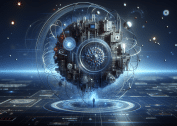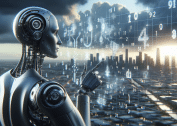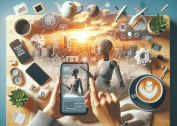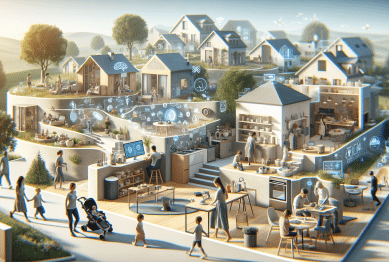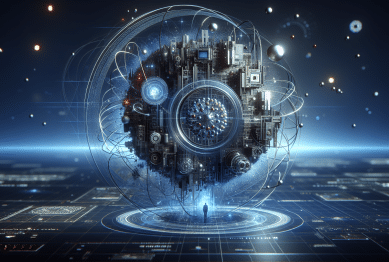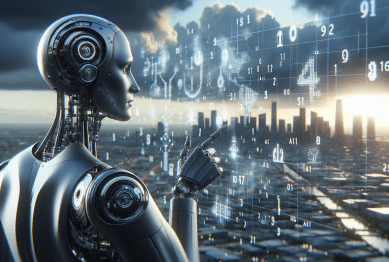Artificial Intelligence is changing daily routines in real and subtle ways. Unlock how AI touches transportation, health, communication, work, and more—often without notice. Explore the technology’s hidden impact and surprising uses that shape everyday experiences.
Unlocking AI’s Quiet Influence in Everyday Experiences
Artificial intelligence, often called AI, shapes many daily experiences in ways people may scarcely realize. From online shopping recommendations to the way maps suggest the fastest route, machine learning algorithms are involved. AI’s reach extends far beyond devices, weaving itself into countless routines and services. It often works invisibly in the background. For instance, voice assistants in smartphones use natural language processing and data-driven logic to interpret requests and answer questions. These systems rely on enormous data sets to continually improve efficiency and responsiveness, making everyday interactions smoother and more intuitive. Such advancements reflect how AI is becoming more accessible—sometimes in subtle ways, sometimes in ways that reshape entire industries.
AI-driven personalization is commonplace, especially on social media and streaming platforms. The content feeds presented to many users rely on complex models that analyze behavior, preferences, and interests. This creates a unique digital environment for each individual, enhancing engagement and providing content that feels relevant. Even everyday tasks like spam filtering in email, scheduling reminders, or auto-tagging faces in photos all leverage AI’s pattern recognition powers. These examples illustrate how artificial intelligence systems have quietly but powerfully become woven into the fabric of modern life, influencing the user experience subtly behind the scenes.
Understanding AI’s role in daily life also means recognizing its potential to support decision-making and convenience. Smart thermostats that adjust temperatures based on learned preferences, or ride-hailing apps that dynamically price trips, show how interconnected AI has become. AI’s utility extends to nearly every domain—from grocery shopping to choosing a playlist for a workout. Its adaptability and ability to learn continuously make it a key enabler of the so-called smart lifestyle many people now enjoy. The more AI evolves, the more its invisible impact is likely to expand.
AI in Healthcare: Subtle Changes, Big Results
Within healthcare, AI has shown its power in diagnostics, data analysis, and even patient communication. Medical imaging technologies, for example, now use artificial intelligence to analyze scans and flag abnormalities, sometimes before a human observer notices them. This early detection advantage can lead to better patient outcomes. In many hospital systems, AI chatbots provide quick answers to patient questions or assist with scheduling appointments. Such tools allow for more streamlined experiences, as well as helping medical teams focus efforts on more complex patient needs. AI-powered symptom checkers and recommendations encourage proactive health management for millions, illustrating the breadth of its silent support.
Data generated by wearable health trackers is also changing the approach to personal wellness. These devices monitor everything from sleep patterns to heart rates, sending data to algorithms that identify trends or potential issues. Individuals can then access insights or suggestions for improvement, all personalized by sophisticated data analytics. AI helps develop new treatments or spot trends in diseases that once took years to analyze manually. Thus, while the technology remains largely unnoticed on the surface, it fosters a new kind of personalized care and early intervention strategy, driving the next frontier in health and wellness.
Furthermore, AI assists healthcare teams with administrative work, such as interpreting records or flagging insurance claims that need attention. This automation reduces manual workload, helping care providers focus more on patients. Even drug discovery is experiencing an acceleration due to AI’s pattern search capabilities. The integration of artificial intelligence into many healthcare layers illustrates its transformative reach. As medical AI applications continue to grow, their support behind the scenes becomes an indispensable part of wellness infrastructure.
Smart Homes and Connected Living Made Possible by AI
Artificial intelligence is a key player in the growing smart home sector. Voice-activated assistants, smart lighting, and security cameras rely on algorithms that learn routines and preferences, offering users unprecedented control. Daily tasks like setting reminders, checking the weather, or controlling appliances are seamless thanks to machine-learning enhancements. Smart refrigerators can now track expiration dates and suggest recipes, while AI-enabled energy monitors help reduce utility bills by optimizing usage. The result is both greater efficiency and convenience, providing a tailored environment for daily life.
Energy efficiency is another area where AI creates value inside homes. Smart thermostats adapt to household behavior, learning when to adjust temperatures for comfort and savings. These systems consider multiple variables—like weather forecasts, household activity, or energy prices—to keep homes optimally climate-controlled. Over time, adaptive machine learning means that the system’s predictions and suggestions grow more precise. Integrating devices throughout the home, such as lighting and entertainment systems, becomes easier as AI bridges the gap between individual device preferences and whole-home orchestration.
Home security is another important layer where AI steps in. Cameras use facial recognition to detect familiar faces, sending alerts when unrecognized activity occurs. AI also powers anomaly detection in home networks and IoT devices, flagging potential breaches or unusual traffic patterns. This means threats can be detected and responded to faster. Overall, connected living is growing more sophisticated as AI tools streamline comfort, safety, and energy management—all while learning from patterns and adapting to lifestyle shifts over time.
AI and Work: Rethinking the Nature of Productivity
Artificial intelligence is changing how businesses and individuals approach work. Automation now streamlines repetitive tasks, freeing employees to focus on creative or strategic efforts. Within offices, smart scheduling tools use AI to optimize calendars based on priorities and deadlines, reducing time spent on logistics. Sentiment analysis tools, powered by machine learning, help gauge feedback and improve customer service interactions. Overall, the digital workplace is experiencing a quiet revolution, where AI blends into workflows and enhances output in subtle but far-reaching ways.
Remote work has further accelerated the adoption of AI-centric solutions. Team collaboration platforms use artificial intelligence to manage document sharing, highlight urgent communications, and recommend project resources. Video meeting platforms now embed AI that automatically adjusts audio or video quality, provides real-time translation, and even generates meeting summaries. Such capabilities improve efficiency and help distributed workforces stay connected, all by leveraging the silent competence of AI-driven tools in the background.
Talent acquisition and workforce planning now also depend on advanced algorithms that scan résumés, match criteria, and flag promising candidates for review. These systems can reduce hiring biases and speed up recruitment cycles. AI supports ongoing employee training through adaptive learning modules that personalize content to each user. Even performance analytics are being guided by artificial intelligence, which can identify trends, flag areas for improvement, and help inform leadership decisions. Productivity, therefore, becomes not just about working harder, but about working smarter through AI’s supportive influence.
Shaping Transportation and Urban Mobility with AI
Transportation solutions have been rapidly transformed by the inclusion of AI technology. Navigation apps rely heavily on real-time data and predictive analytics to suggest routes, helping millions arrive faster and safer. Machine learning processes huge amounts of data to consider traffic conditions, accidents, or road closures, constantly updating to give drivers the best travel information. Ride-sharing platforms also depend on AI to match drivers with passengers and dynamically adjust fares. These elements collectively create a smarter urban mobility ecosystem that adapts to changing demands in real time.
Within public transit, AI models predict service demand, optimize scheduling, and inform maintenance. Some cities use data-driven surveillance and anomaly detection to improve safety and address issues as they emerge. Autonomous vehicles, supported by complex neural networks and sensor fusion, are on the rise. While their broad adoption remains under development, pilot programs show promise for reducing accidents due to human error and improving transport inclusivity for older adults or people with disabilities. AI-powered traffic management and predictive analytics also help reduce carbon emissions by minimizing idling and congestion in busy urban centers.
Even micromobility—like shared scooters or bikes—utilizes AI for fleet positioning, predicting maintenance needs, and optimizing station locations. As urban populations grow and cities face increasing transportation challenges, artificial intelligence offers adaptive, scalable solutions that can improve efficiency, accessibility, and environmental impact. Smart mobility is no longer a distant vision—it’s embedded in the infrastructure of daily movement for many.
Looking Ahead: Challenges and Ethical Questions for AI Integration
With artificial intelligence so deeply integrated into daily life, questions arise about transparency, privacy, and ethical considerations. Machine learning models use immense volumes of personal data for personalization and predictions, raising concerns about data security and potential misuse. Regulators and advocacy groups now debate how to ensure AI is used responsibly and transparently in ways that respect user rights. Building public trust hinges on accountability and clear communication regarding how these systems operate behind the scenes.
Bias within AI models is another challenge. Algorithms can unintentionally reinforce societal biases if they are trained on unrepresentative or flawed data. Technology companies are increasingly investing in fairness and bias-mitigation research to ensure equitable results for users of all backgrounds. Both ongoing education and robust regulatory frameworks are needed to address unintended consequences as artificial intelligence becomes more advanced and widespread over time.
Finally, as AI becomes more autonomous in making decisions—whether in healthcare, finance, or daily conveniences—many question where responsibility lies if errors occur. Designing explainable AI systems is crucial, allowing users and professionals to understand the rationale behind decisions. Open discussions and transparent progress can help society harness AI’s benefits while minimizing risk. As the technology grows more powerful, ethical stewardship will shape how it continues to transform the future.
References
1. National Institute of Standards and Technology. (n.d.). Artificial Intelligence. Retrieved from https://www.nist.gov/artificial-intelligence
2. Mayo Clinic. (n.d.). Artificial Intelligence in Healthcare. Retrieved from https://www.mayoclinic.org/artificial-intelligence
3. United States Department of Energy. (n.d.). Smart Home Technologies. Retrieved from https://www.energy.gov/eere/buildings/articles/smart-homes
4. European Commission. (n.d.). Artificial Intelligence for Transport. Retrieved from https://transport.ec.europa.eu/topics/research-and-innovation/transport-technologies/automated-and-connected-mobility/artificial-intelligence_en
5. Brookings Institution. (n.d.). Algorithmic bias detection and mitigation: Best practices and policies. Retrieved from https://www.brookings.edu/articles/algorithmic-bias-detection-and-mitigation-best-practices-and-policies/
6. Harvard University Berkman Klein Center. (n.d.). Ethics and Governance of Artificial Intelligence. Retrieved from https://cyber.harvard.edu/research/ai/governance



